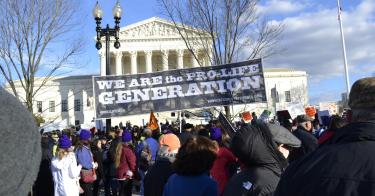Last September Donald Trump committed to “work to support the dignity of human life from conception to natural, dignified death.” Now that he is officially president, pro-life Americans will watch closely to see how the new administration follows through on this unambiguous commitment to defend life.
President Trump can take several pro-life actions now that he sits inside the Oval Office. For starters, he could reinstate the Mexico City Policy to ensure that federally-funded international nongovernmental organizations do not perform or actively promote abortion as a method of family planning.
He can rescind President Obama's executive order allowing human embryonic stem cell research. And he can strengthen the prohibition on so-called "3-parent embryos."
Trump can also make good on his campaign promise by nominating a Supreme Court justice who will respect the Constitution and the fundamental right to life.
There's much a Trump administration can do at the department level as well. At the Department of Health and Human Services alone, the list of pro-life actions that can be taken includes:
1. Enforcing the Weldon Amendment to stop states from unlawfully discriminating against health care entities that refuse to pay for or cover abortions.
2. Reaffirming states' freedom to exclude abortion providers from state Medicaid programs by rescinding a 2011 Center for Medicaid, CHIP and Survey & Certification (CMCS) informational bulletin.
3. Updating Title X regulations regarding abortion and adoption to ensure that organizations receiving Title X funding maintain strict physical and accounting separation between family planning activities and abortion services and do not provide counseling or referral for abortions.Similar regulations were promulgated under President Ronald Reagan in 1988 and upheld by the Supreme Court in Rust v. Sullivan. Title X regulations should also include a requirement that recipients offer pregnant women information and counseling on adoption (currently, adoption counseling is merely optional).
4. Reinstate the conscience protections for health care providers which though finalized via rule-making in the waning days of the Bush administration, were largely rescinded by President Obama in 2011.
Potential pro-life action for the Trump administration is by no means limited to executive orders or HHS policy-making. Under the Kemp-Kasten amendment, President Trump has the authority to withhold funding for the United Nations Population Fund (UNFPA), which has repeatedly been reported to be complicit with the Chinese government’s draconian family planning program.
The new administration can also commit to enforcing the Helms amendment and other longstanding prohibitions on funding abortion in international programs. More broadly, it can ensure that every government agency involved with the federal grant process does not discriminate against faith-based, life-affirming organizations.Trump has also committed to sign new pro-life legislation from Congress. This presents the opportunity to:
1. Stop federal funding to Planned Parenthood in light of the criminal referrals stemming from reports of the organization's involvement in the sale of the body parts of aborted babies, and reallocate family planning dollars to entities not entangled with the abortion industry.
2. End taxpayer funding for abortion once and for all by making the Hyde Amendment permanent law. A strong majority of Americans, including many who identify as pro-choice, oppose taxpayer-funded abortions.
3. Enact the Pain-Capable Unborn Child Protection Act, which would end painful late-term abortions nationwide. Nearly 8 in 10 Americans support limiting abortion to the first three months of pregnancy, yet the U.S. is one of only seven nations that allow late-term abortions for any reason.
On Friday, January 27, just days after President Trump took the oath of office,, tens of thousands of Americans will descend on Washington, D.C. for the annual March for Life.For more than 40 years this peaceful demonstration has been held following the somber anniversary of the Supreme Court effectively legalizing abortion on demand in 1973.
Since that fateful January day, more than 58 million innocent boys and girls have been legally denied the opportunity to live.
The March brings together young and old, men and women, religious and secular. All are united in their desire to witness to the fundamental truth that from the moment of conception, a distinct human being with inherent worth and dignity has a right to life.As the March for Life gathers this week, pro-life leaders are hopeful that their voices will be heard and have new impact as a new administration and new Congress get to work.
This piece originally appeared in The Hill


